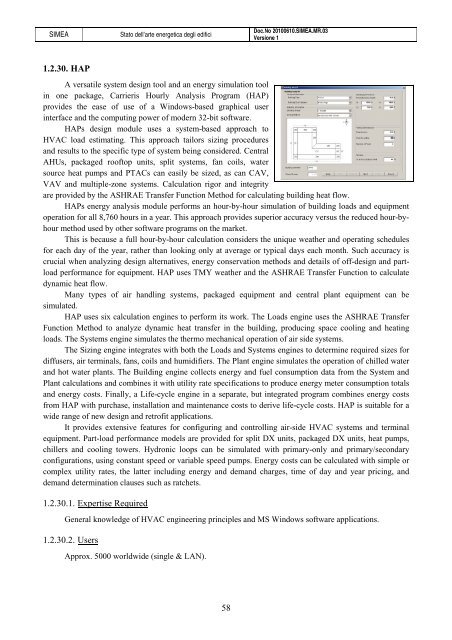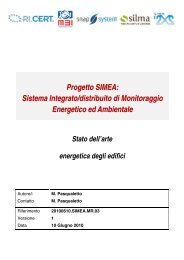Progetto SIMEA - Automatica - Università degli Studi di Padova
Progetto SIMEA - Automatica - Università degli Studi di Padova
Progetto SIMEA - Automatica - Università degli Studi di Padova
You also want an ePaper? Increase the reach of your titles
YUMPU automatically turns print PDFs into web optimized ePapers that Google loves.
<strong>SIMEA</strong> Stato dell’arte energetica <strong>degli</strong> e<strong>di</strong>fici<br />
1.2.30. HAP<br />
58<br />
Doc.No 20100610.<strong>SIMEA</strong>.MR.03<br />
Versione 1<br />
A versatile system design tool and an energy simulation tool<br />
in one package, Carrieris Hourly Analysis Program (HAP)<br />
provides the ease of use of a Windows-based graphical user<br />
interface and the computing power of modern 32-bit software.<br />
HAPs design module uses a system-based approach to<br />
HVAC load estimating. This approach tailors sizing procedures<br />
and results to the specific type of system being considered. Central<br />
AHUs, packaged rooftop units, split systems, fan coils, water<br />
source heat pumps and PTACs can easily be sized, as can CAV,<br />
VAV and multiple-zone systems. Calculation rigor and integrity<br />
are provided by the ASHRAE Transfer Function Method for calculating buil<strong>di</strong>ng heat flow.<br />
HAPs energy analysis module performs an hour-by-hour simulation of buil<strong>di</strong>ng loads and equipment<br />
operation for all 8,760 hours in a year. This approach provides superior accuracy versus the reduced hour-byhour<br />
method used by other software programs on the market.<br />
This is because a full hour-by-hour calculation considers the unique weather and operating schedules<br />
for each day of the year, rather than looking only at average or typical days each month. Such accuracy is<br />
crucial when analyzing design alternatives, energy conservation methods and details of off-design and partload<br />
performance for equipment. HAP uses TMY weather and the ASHRAE Transfer Function to calculate<br />
dynamic heat flow.<br />
Many types of air handling systems, packaged equipment and central plant equipment can be<br />
simulated.<br />
HAP uses six calculation engines to perform its work. The Loads engine uses the ASHRAE Transfer<br />
Function Method to analyze dynamic heat transfer in the buil<strong>di</strong>ng, producing space cooling and heating<br />
loads. The Systems engine simulates the thermo mechanical operation of air side systems.<br />
The Sizing engine integrates with both the Loads and Systems engines to determine required sizes for<br />
<strong>di</strong>ffusers, air terminals, fans, coils and humi<strong>di</strong>fiers. The Plant engine simulates the operation of chilled water<br />
and hot water plants. The Buil<strong>di</strong>ng engine collects energy and fuel consumption data from the System and<br />
Plant calculations and combines it with utility rate specifications to produce energy meter consumption totals<br />
and energy costs. Finally, a Life-cycle engine in a separate, but integrated program combines energy costs<br />
from HAP with purchase, installation and maintenance costs to derive life-cycle costs. HAP is suitable for a<br />
wide range of new design and retrofit applications.<br />
It provides extensive features for configuring and controlling air-side HVAC systems and terminal<br />
equipment. Part-load performance models are provided for split DX units, packaged DX units, heat pumps,<br />
chillers and cooling towers. Hydronic loops can be simulated with primary-only and primary/secondary<br />
configurations, using constant speed or variable speed pumps. Energy costs can be calculated with simple or<br />
complex utility rates, the latter inclu<strong>di</strong>ng energy and demand charges, time of day and year pricing, and<br />
demand determination clauses such as ratchets.<br />
1.2.30.1. Expertise Required<br />
General knowledge of HVAC engineering principles and MS Windows software applications.<br />
1.2.30.2. Users<br />
Approx. 5000 worldwide (single & LAN).
















